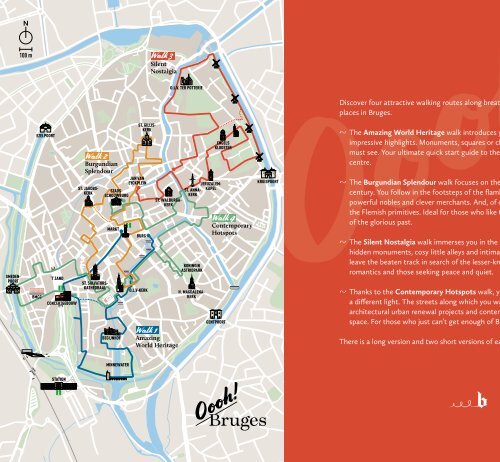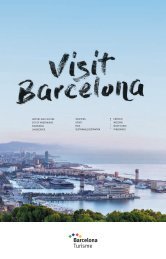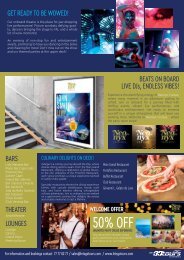You also want an ePaper? Increase the reach of your titles
YUMPU automatically turns print PDFs into web optimized ePapers that Google loves.
VISIT<br />
BRUGES<br />
100 m<br />
Walk 3<br />
Silent<br />
Nostalgia<br />
O.L.V. TER POTTERIE<br />
SMEDEN-<br />
POORT<br />
EZELPOORT<br />
BMCC<br />
‘T ZAND<br />
CONCERTGEBOUW<br />
Walk 2<br />
Burgundian<br />
Splendour<br />
ST. JAKOBS-<br />
KERK<br />
ST. SALVATORS-<br />
KATHEDRAAL<br />
STADS-<br />
SCHOUWBURG<br />
MARKT<br />
BEGIJNHOF<br />
ST. GILLIS-<br />
KERK<br />
JAN VAN<br />
EYCKPLEIN<br />
BURG<br />
O.L.V-KERK<br />
ST. WALBURGA-<br />
KERK<br />
Walk 1<br />
Amazing<br />
World Heritage<br />
JERUZALEM-<br />
ST. ANNA- KAPEL<br />
KERK<br />
KONINGIN<br />
ASTRIDPARK<br />
H. MAGDALENA-<br />
KERK<br />
ENGELS<br />
KLOOSTER<br />
Walk 4<br />
Contemporary<br />
Hotspots<br />
GENTPOORT<br />
KRUISPOORT<br />
Discover four attractive walking routes along breathtaking and surprising<br />
places in <strong>Bruges</strong>.<br />
The Amazing World Heritage walk introduces you to the city’s most<br />
impressive highlights. Monuments, squares or churches that you simply<br />
must see. Your ultimate quick start guide to the best of <strong>Bruges</strong> in the city<br />
centre.<br />
The Burgundian Splendour walk focuses on the heyday of the 15th<br />
century. You follow in the footsteps of the flamboyant Burgundian court,<br />
powerful nobles and clever merchants. And, of course, we mustn’t forget<br />
the Flemish primitives. Ideal for those who like to spend a while dreaming<br />
of the glorious past.<br />
The Silent Nostalgia walk immerses you in the hushed atmosphere of<br />
hidden monuments, cosy little alleys and intimate green spaces. You<br />
leave the beaten track in search of the lesser-known <strong>Bruges</strong>. A must for<br />
romantics and those seeking peace and quiet.<br />
Thanks to the Contemporary Hotspots walk, you view the city in<br />
a different light. The streets along which you walk take you past<br />
architectural urban renewal projects and contemporary art in the public<br />
space. For those who just can’t get enough of <strong>Bruges</strong>.<br />
There is a long version and two short versions of each walk.<br />
Oooh! Discover <strong>Bruges</strong> through four walking routes<br />
MINNEWATER<br />
STATION<br />
Discover <strong>Bruges</strong> through<br />
four walking routes<br />
EN<br />
EN
History in a nutshell<br />
Walk 1<br />
Must-sees: Amazing World Heritage<br />
Walk 2<br />
Luxury and bling-bling: Burgundian Splendour<br />
Walk 3<br />
Calm and collected: Silent Nostalgia<br />
Walk 4<br />
Surprisingly now: Contemporary Hotspots<br />
1<br />
Practical info<br />
Tourist offices ― p. 109<br />
Index ― p. 110<br />
City map
Must-sees:<br />
Amazing World Heritage<br />
Walk 1<br />
Walk 1<br />
4 km<br />
± 2.30 hours<br />
9
Academiestraat<br />
Jan van<br />
Eyckplein<br />
100 m<br />
Koning Albert I-laan<br />
Smedenstraat<br />
BEURSPLEIN<br />
Hoefijzerlaan<br />
Hauwerstraat<br />
Boeveriestraat<br />
BOEVERIEPOORT<br />
Vrijdagmarkt<br />
‘T ZAND<br />
15<br />
Koning Albert I-laan<br />
STATION<br />
Noordzandstraat<br />
Dweersstraat<br />
Zuidzandstraat<br />
14<br />
Westmeers<br />
Zilverpand<br />
Lendestr.<br />
Kapucijnenplein<br />
St.-Jan<br />
in de Meers<br />
13<br />
Koning<br />
Albert I-park<br />
Buiten Begijnenvest<br />
Eiland<br />
Bakkersstr.<br />
Koolbrandersstr.<br />
St.-Obrechtsstr.<br />
Oostmeers<br />
16<br />
Oostmeers<br />
Garsoenstr.<br />
Sint-Jakobsstraat<br />
Begijnenvest<br />
Geldmuntstraat<br />
Kemelstr.<br />
Zilverstraat<br />
St.-S a lvators k erkhof<br />
Zonnekemeers<br />
Kuipersstraat<br />
Eiermarkt<br />
St.-Amandsstraat<br />
Steenstraat<br />
17<br />
Simon<br />
Stevinplein<br />
OUD SINT-JAN<br />
Congrescentrum<br />
Mariastraat<br />
BEGIJNHOF<br />
12<br />
10<br />
Poertorenpark<br />
Vlamingstraat<br />
MARKT<br />
18<br />
St.-Niklaasstr.<br />
Oude Burg<br />
Nieuwstraat<br />
8<br />
9<br />
Hallestraat<br />
Gruuthusestr.<br />
Philipstockstraat<br />
Walstraat<br />
Walplein<br />
11<br />
7<br />
Minnewater<br />
Minnewaterpark<br />
Breidelstraat<br />
Wollestraat<br />
6<br />
5<br />
Groeninge<br />
Huidenvettersplein<br />
Unescorotonde<br />
Wijngaardplein<br />
Zilversteeg<br />
O.L.V.-<br />
kerkhof-Zuid<br />
Wijngaardstr.<br />
Hof<br />
Arents<br />
Bargeplein<br />
Burgstr.<br />
Dijver<br />
Arsenaalstraat<br />
KANAALEILAND<br />
BURG<br />
1<br />
Rozenhoedkaai<br />
Kraanplein<br />
Stationsplein<br />
St.-Walburgastraat<br />
Katelijnestraat<br />
3<br />
4<br />
Eekhoutstraat<br />
Hoogstraat<br />
Steenhouwersdijk<br />
2<br />
Vismarkt<br />
Oude Gentweg<br />
KATELIJNEPOORT<br />
Braambergstr.<br />
Garenmarkt<br />
This walk takes you through the tourist centre of <strong>Bruges</strong>.<br />
It’s an absolute must for anyone visiting the city for the first time.<br />
In just a few hours, you will walk past all the highlights of the city centre’s rich<br />
world heritage. Past stunning city palaces, towering churches and centuries-old<br />
squares. A solid chunk of history and amusing anecdotes will keep you company<br />
on the way. Some quality time for those enjoying life!<br />
Walk 1<br />
1 Burg (Burg Square)<br />
2 Vismarkt (Fish Market)<br />
3 Huidenvettersplein<br />
(Tanners Square)<br />
4 Rozenhoedkaai (Rosary Quay)<br />
5 Dijver<br />
6 Hof Arents<br />
7 Gruuthusemuseum en<br />
O.L.V.-kerk (Gruuthuse Museum<br />
and Church of Our Lady)<br />
8 Sint-Janshospitaal<br />
(St John’s Hospital)<br />
9 Walplein<br />
10 Begijnhof (Beguinage)<br />
10 11<br />
11 Minnewater (Lake of Love)<br />
12 Vesten en Poertoren<br />
(City Ramparts and Gunpowder<br />
Tower)<br />
13 Koning Albert I-park<br />
(King Albert I Park)<br />
14 Concertgebouw Brugge<br />
(Concert Hall)<br />
15 ’t Zand (’t Zand Square)<br />
16 Sint-Salvatorskathedraal<br />
(St Saviour’s Cathedral)<br />
17 Simon Stevinplein<br />
(Simon Stevin Square)<br />
18 Markt (Market Square)<br />
Good to know: there is a long version and two short versions of this walk.<br />
Consult the map ( ) to decide the most convenient route for you.<br />
Walk 1
1 BURG SQUARE<br />
Birthplace of the city<br />
To the right of the City Hall you can<br />
make out the Basilica of the Holy<br />
Blood. Wander around the lower<br />
chapel (the only well-preserved<br />
Romanesque church building in<br />
West Flanders) and marvel at the<br />
neo-Gothic upper chapel. The relic<br />
of the Holy Blood has been kept here<br />
since the 13th century (see page 90).<br />
To the left of the City Hall is the<br />
former Civil Registry with its<br />
Renaissance façade. The building<br />
is connected to the City Hall from<br />
above, as clerks from the city council<br />
worked here as early as the 16th<br />
century.<br />
complex. The Liberty of <strong>Bruges</strong> had<br />
previously occupied several locations<br />
on Burg Square and was abolished by<br />
the French in 1795.<br />
Both the Civil Registry and the<br />
Liberty of <strong>Bruges</strong> Manor now house<br />
the city services. Anyone who visits<br />
the Liberty of <strong>Bruges</strong> will be blown<br />
away by the monumental fireplace<br />
dating back to 1528, designed<br />
by Renaissance artist Lanceloot<br />
Blondeel.<br />
Walk 1<br />
From the 9th century onwards,<br />
<strong>Bruges</strong> grew out of Burg Square,<br />
which has served as the city’s<br />
administrative centre for centuries.<br />
The Counts of Flanders had their<br />
residence here, and today the City<br />
Hall is home to <strong>Bruges</strong>’ city council.<br />
The majestic buildings, some of<br />
which you can visit, emphasise Burg<br />
Square’s role as a centre of power.<br />
In the middle stands the 14thcentury<br />
Gothic City Hall, one of the<br />
oldest in the Low Countries and a<br />
model for the city halls of Leuven<br />
and Brussels, among others. The<br />
innovative use of façade sculptures<br />
was particularly admired at the time.<br />
The impressive Gothic Hall is an<br />
absolute must-see. <strong>Bruges</strong> couples<br />
still get married here and it is where<br />
the city council meets.<br />
Burg Square and Market<br />
Square, then and now<br />
Walk into the City Hall and view<br />
the paintings of Burg Square and<br />
Market Square in the foyer. They<br />
show how the squares looked in the<br />
17th century. The painting of Burg<br />
Square (see page 45) features the<br />
lost St Donatian’s Cathedral, and<br />
you can also see that the Liberty<br />
of <strong>Bruges</strong> Manor looked quite<br />
different too.<br />
The painting of Market Square (see<br />
page 4) shows the Water Halls,<br />
which were demolished in the 18th<br />
century, and on top of the Belfry<br />
there is a wooden spire. It burned<br />
down twice, after which the city<br />
decided not to rebuild it again.<br />
Next to it is the Liberty of <strong>Bruges</strong><br />
Manor. Since the 18th century, the<br />
countryside around <strong>Bruges</strong> had<br />
the status of a separate area and<br />
was governed from this classicist<br />
Oooh!<br />
Did you know that... a bear is the city’s oldest resident?<br />
It’s the mid-9th century, imagine a winter landscape. Baldwin I, first Count of<br />
Flanders, arrives in the vicinity of Burg Square. The first ‘resident’ he meets is<br />
a large brown bear, covered in snow. After a fierce fight, he manages to kill the<br />
animal and, as a tribute, proclaims it a symbol of the city. From the 16th century<br />
onwards, the bear appears in the <strong>Bruges</strong> city coat of arms, such as above the<br />
door of the Civil Registry.<br />
12 13
2 FISH MARKET<br />
Oldest fish market in Belgium<br />
Fresh North Sea fish used to be<br />
a delicacy for the rich, and was<br />
originally sold on Market Square.<br />
However, in the 18th century,<br />
because of the unpleasant smell, the<br />
fishmongers were banished to this<br />
square, which has since been called<br />
Fish Market. Originally, the fish<br />
was sold from wooden stalls in the<br />
open air. Until city architect Jean-<br />
Robert Calloigne was commissioned<br />
to design a colonnade to provide<br />
shelter in 1820. This building is now<br />
the oldest preserved fish market in<br />
Belgium.<br />
The classicist building rests on 126<br />
Tuscan columns, recognisable by<br />
their smooth shafts. Due to its sober<br />
and severe appearance, this type of<br />
column often appears in functional<br />
architecture such as warehouses,<br />
barracks or market halls.<br />
In the courtyard there is a water<br />
pump with an Egyptian-looking<br />
obelisk, a fashionable trend at the<br />
time. On the north side, you will<br />
notice a small square courtyard with<br />
a railing. In the past, the fish were<br />
displayed and auctioned here after<br />
they arrived.<br />
Fancy some fish?<br />
You can still buy seafood and fish<br />
preparations at the Fish Market<br />
(every morning from Wednesday<br />
to Saturday inclusive). Vendors<br />
of handmade goods also happily<br />
display their wares here. The<br />
weekly market selling food<br />
products can be found on Market<br />
Square every Wednesday. On<br />
Dijver, there is an antique and brica-brac<br />
market at the weekend and<br />
on public holidays.<br />
3 TANNERS SQUARE<br />
From skin to leather<br />
While the Fish Market served the<br />
rich, the poor of the 19th century<br />
bought cheap freshwater fish on<br />
Tanners Square, referred to locally<br />
as ‘the little Fish Market’. Originally,<br />
however, the square was the domain<br />
of the tanners. Did the distinctive<br />
pole in the middle once hold the<br />
scales for weighing skins (and later<br />
fish)? Nobody knows for sure. The<br />
column that stands there now<br />
only dates from 1925; two lions are<br />
holding the tanners’ coat of arms.<br />
Now look at the large building with<br />
the almost windowless wall on the<br />
top floor. It is the guild house of the<br />
tanners, restored according to the<br />
17th century model. This is where<br />
they stored and sold their animal<br />
skins that had been processed into<br />
leather. The adjacent building on<br />
the right was named ‘De Groote<br />
Hollander’ after the breed of cow<br />
with the same name. The cow is<br />
depicted above the door and scenes<br />
of leather processing adorn the<br />
façade. This was the inn where the<br />
tanners liked to relax. Traditional<br />
leather processing involved different<br />
working methods, depending on<br />
whether the end product was a<br />
wallet, shoe or something else. The<br />
entire process could take up to a<br />
few years and due to the unhealthy<br />
air in which they worked, tanners<br />
often died at a young age. The dirtylooking<br />
little man on the corner of<br />
the guild house thus rightly turns his<br />
nose up.<br />
4 ROSARY QUAY<br />
A postcard from <strong>Bruges</strong><br />
If you want to make an impression<br />
on Instagram, you should definitely<br />
take some photos on Rosary Quay.<br />
Until the end of the 18th century,<br />
this place was called Salt Dike,<br />
because this is where the ships<br />
moored to unload salt. They did<br />
so in vast quantities, because salt<br />
was the gold of the Middle Ages.<br />
Walk 1<br />
14 15
You could store food in it and use<br />
it to season dishes. Words like<br />
‘salaris’, ‘salaire’ and ‘salary’, which<br />
come from the Latin word for salt<br />
‘sal’, indicate the product’s value.<br />
Even Roman soldiers were paid in<br />
salt. But how do we make the leap<br />
from Salt Quay to Rosary Quay?<br />
Well, the quay was also the place<br />
to be if you wanted to buy a rosary.<br />
Nowadays, you won’t find any stalls<br />
selling rosaries here, but the street<br />
name (Rozenhoedkaai) refers to an<br />
abbreviated version of a ‘rosary’. The<br />
believer usually works his or her<br />
way around the prayer beads three<br />
times and says a prayer at each bead.<br />
With the abbreviated ‘rosary’ (a<br />
‘rozenhoedje’), a single round applies.<br />
The fancier rosaries at the time<br />
contained precious African ivory or<br />
amber from the Baltic shores. Until<br />
the end of the 15th century, <strong>Bruges</strong><br />
and Lübeck in Germany were the<br />
only two European cities that were<br />
permitted to work amber. A privilege<br />
Oooh!<br />
Did you know that... there is a<br />
good reason why Pandreitje is<br />
so wide?<br />
Pandreitje is situated perpendicular<br />
to Rosary Quay. Until the end of the<br />
18th century, there was a street and<br />
a small canal here. At some point,<br />
the canal was filled in, which explains<br />
why the street is so wide. However,<br />
it would take 24 years to complete<br />
the job, as the city council wanted<br />
builders to dump their rubble in<br />
it. The trees were planted a good<br />
century later and are among the<br />
oldest plane trees in the city. Curious<br />
about the gatehouse at the end of<br />
the street? If so, turn to 10 .<br />
that certainly did not do the rosary<br />
makers of <strong>Bruges</strong> any harm.<br />
5 DIJVER<br />
From holy water<br />
to the College of Europe<br />
Due to the absence of quay walls,<br />
Dijver is the only place in the city<br />
where the Reie has, to a certain<br />
extent, preserved its natural<br />
appearance. Yet this canal is not<br />
called ‘rei’ as is the case almost<br />
everywhere else, but Dijver, which<br />
means ‘holy water’ in Celtic. It is<br />
possibly the oldest place name in<br />
the city. Due to the presence of a<br />
forest of oak trees - sacred to the<br />
Celts - they most likely considered<br />
this spot along the water as a<br />
sacred cult site. While this place<br />
once served as a cult site, today<br />
culture and education are the<br />
dominant forces, as the Groeninge<br />
Museum and the College of Europe<br />
are located here. The Groeninge<br />
Museum is <strong>Bruges</strong>’ most renowned<br />
museum with world-famous works<br />
by the Flemish primitives (read<br />
more at 3 ). The idea of the College<br />
of Europe (see also 5 ) was born<br />
shortly after the Second World<br />
War. At the time, a number of<br />
political leaders, including Winston<br />
Churchill, met in The Hague.<br />
They dreamed of an independent<br />
institute where students of different<br />
nationalities would study and live<br />
together. European cooperation<br />
and integration on a limited scale,<br />
so to speak, a fine exercise for the<br />
‘real’ Europe. A group of enthusiastic<br />
<strong>Bruges</strong> citizens made an effort to<br />
establish this institute in <strong>Bruges</strong>,<br />
and the rest is history. The College<br />
of Europe can proudly call itself the<br />
very first European postgraduate<br />
college in the world. Its headquarters<br />
and administration is located on<br />
Dijver, but the institute has teaching<br />
and accommodation facilities<br />
throughout the city centre.<br />
Sailing on the canals<br />
A boat trip on the canals of <strong>Bruges</strong><br />
is an absolute must. For half an<br />
hour, you will experience <strong>Bruges</strong><br />
from a surprising perspective.<br />
Towers and palaces seem doubly<br />
impressive! Rocking on the swell,<br />
you pass under century-old bridges<br />
or feel like a guest in one of the<br />
romantic waterfront gardens.<br />
And a boat trip is becoming even<br />
more enjoyable as the shipping<br />
companies are gradually switching<br />
to a sustainable electric fleet. You<br />
can jump on at one of the five<br />
jetties in the centre, indicated on<br />
the map by .<br />
All the boats follow the same route<br />
and sailings are guaranteed from<br />
March to mid-November.<br />
Walk 1<br />
16<br />
16 17
6 HOF ARENTS<br />
Intimate city park<br />
with a museum<br />
Hof Arents was once the private<br />
garden of the manor house you<br />
see on the bridge to the nearby<br />
Gruuthuse domain. At the beginning<br />
of the 20th century, the city decided<br />
to purchase the classicist building<br />
with its 18th-century coach house<br />
and garden. The house and garden<br />
were named after the last owner,<br />
Aquilin Arents de Beertegem. The<br />
garden was turned into an intimate<br />
city park with an artistic touch.<br />
Take the time to stop by the group<br />
of bronze sculptures in the middle.<br />
These are the Four Horsemen of<br />
the Apocalypse by Belgian artist<br />
Rik Poot, a chilling evocation of<br />
revolution, war, hunger and death<br />
(read more at 12 ). The stone<br />
columns also stand out.<br />
They are the only remnants of the<br />
Water Halls, a large covered hall that<br />
once stood on Market Square<br />
(see also 6 ).<br />
A museum housing the oeuvre of the<br />
British-<strong>Bruges</strong> artist Frank Brangwyn<br />
was created in the elegant manor<br />
house. He was a multi-talented<br />
artist who moved effortlessly<br />
between paintings, watercolours,<br />
drawings, furniture, carpets and<br />
pottery. He donated a significant<br />
part of his collection to the city.<br />
The ground floor of the House<br />
Arents offers space for temporary<br />
presentations from the collections<br />
of the Groeninge Museum and<br />
the municipal Print Room. Since<br />
2002, the former coach house has<br />
been home to Musea Brugge’s main<br />
museum shop. Be sure to pop in to<br />
buy a stylish memento or gift.<br />
7 GRUUTHUSE MUSEUM<br />
AND CHURCH OF OUR LADY<br />
Burgundian grandeur<br />
The adorable little Boniface Bridge<br />
offers a great view of two absolute<br />
stunners. On the right, you can see the<br />
Gruuthuse Museum, which focuses<br />
on three important periods of <strong>Bruges</strong>’<br />
history: its Burgundian heyday, the<br />
lesser-known 17th and 18th centuries,<br />
and the historical rediscovery of <strong>Bruges</strong><br />
in the 19th century. Each era comes to<br />
life thanks to a magnificent collection<br />
of ancient objects.<br />
The interior is just as worthy of a visit;<br />
the lavish 15th-century city palace<br />
of the Lords of Gruuthuse houses<br />
the museum. During your visit it<br />
is possible to access the romantic<br />
balcony with a view of the photogenic<br />
surroundings. However, the ultimate<br />
eye-catcher is the authentic, medieval<br />
oratory, which overlooks the Gothic<br />
choir of the Church of Our Lady. Here<br />
the Gruuthuse family attended mass<br />
in private, without having to mingle<br />
with the masses. The oratory was the<br />
ultimate embodiment of their power<br />
and wealth. They had their private<br />
chapel built against the church and so<br />
it literally became part of the church<br />
building itself. What a nerve! During a<br />
visit to the museum, you automatically<br />
pass the oratory, which you can see<br />
from the outside as a roof over the<br />
narrow passage between the palace<br />
and the church. Just stand there for a<br />
moment and shift your gaze upwards<br />
Oooh!<br />
Did you know that... the<br />
Gruuthuses had a tiny window?<br />
A small Gothic window in the<br />
façade of the Gruuthuse Palace<br />
overlooks the water near Boniface<br />
Bridge. In times when electricity<br />
did not yet exist, such windows<br />
provided lighting and ventilation<br />
and were usually located in a corner<br />
at the rear. You could also look<br />
through it to peer outside, but of<br />
course you could not see very much.<br />
<strong>Bruges</strong> has a total of five such<br />
windows. Try and find them. If you<br />
follow all the walks in this guide you<br />
will discover three more windows.<br />
Walk 1<br />
18 19
to take in the monumental Church<br />
of Our Lady. The tower is about<br />
115.5 metres high. <strong>Bruges</strong> builders<br />
worked for no fewer than 200 years<br />
on what eventually became the<br />
second highest brick church tower in<br />
the world. The construction of the<br />
present church started in the early<br />
13th century, but there was a modest<br />
church on this site already in the 9th<br />
century.<br />
The showpiece of the amazing<br />
collection is the white marble<br />
‘Madonna and Child’ by<br />
Michelangelo himself, the only<br />
sculpture that left Italy during his<br />
lifetime.<br />
Curious? At 1 and 13 you can read<br />
more about the Gruuthuse Palace<br />
and the Church of Our Lady.<br />
8 ST JOHN’S HOSPITAL<br />
Eight centuries of healthcare<br />
history<br />
St John’s Hospital (12th century) is<br />
one of the oldest hospital buildings<br />
in Europe. At the time, <strong>Bruges</strong> was<br />
experiencing a growth spurt and<br />
the city council decided to provide<br />
shelter and care for those who<br />
needed it. Mind you, a hospital in<br />
those days was more of a refuge;<br />
the first concern was not to heal<br />
the body, but to care for the soul. St<br />
John’s Hospital welcomed the poor<br />
and the sick, as well as travellers<br />
and pilgrims, because it was located<br />
along one of the most important<br />
approach roads just inside the first<br />
city walls.<br />
much of it was lost to make way for<br />
a new hospital. It was conceived as<br />
a central corridor with the wards<br />
positioned at right angles. This<br />
building still occupies a central<br />
location on the site and serves as<br />
a conference and events venue.<br />
Finally, in the 1970s, AZ Sint-Jan<br />
Hospital was built outside the city<br />
and continues <strong>Bruges</strong>’ centuries-old<br />
medical tradition to this day. The<br />
medieval building complex currently<br />
houses an impressive collection of<br />
medical instruments, as well as a rich<br />
treasure trove of artworks. The seven<br />
works by the Flemish primitive Hans<br />
Memling are the ultimate crowd<br />
pleaser (see also 11 ). The paintings,<br />
furniture, sculptures, pewter and<br />
silverware and much more bear<br />
silent witness to more than 800<br />
years of caring for the sick and the<br />
soul. The monumental oak truss<br />
of the Diksmuide Attic, one of the<br />
oldest in Europe, is also unique.<br />
The hospital pharmacy<br />
Time seems to have stood still<br />
in the 17th century, almost<br />
authentically preserved hospital<br />
pharmacy. It is easy to imagine how<br />
the nuns in their rustling black and<br />
white robes processed the herbs<br />
into medicines. The room served<br />
as a pharmacy, a laboratory and a<br />
nursing room, as a painting at the<br />
site reveals. Another interesting<br />
item is the 'Winckel Bouck', which is<br />
kept in the pharmacy; it is an 18thcentury<br />
recipe book for a number<br />
of commonly made medicines.<br />
The plants found in the book,<br />
such as aniseed, dog rose, fennel<br />
or liquorice root, grow in the herb<br />
beds near the entrance.<br />
Walk 1<br />
At that time, the immense domain<br />
included not only the infirmary with<br />
the church, but also a cemetery,<br />
monastery buildings for the brothers<br />
and the nuns, a brewery, bakery,<br />
pharmacy with herb garden and<br />
an orchard. In the 19th century,<br />
20 21
9 WALPLEIN<br />
Where beer flows underground<br />
Walplein is the home of the official<br />
<strong>Bruges</strong> city beer ‘Brugse Zot’ (<strong>Bruges</strong>’<br />
Fool). Ale has been brewed here<br />
since the 16th century, but real fame<br />
came about thanks to Brewery De<br />
Halve Maan. This authentic and also<br />
oldest city brewery still operating is<br />
a family affair and six generations<br />
of brewers have successively run the<br />
business since 1856.<br />
The name ‘Brugse Zot’ refers to<br />
the nickname that Maximilian of<br />
Austria gave to the people of <strong>Bruges</strong>.<br />
The story goes that at some point,<br />
an exuberant procession of motley<br />
revellers and fools passed through<br />
the streets. When the inhabitants<br />
later asked Maximilian to fund a<br />
new ‘zothuis’ (lunatic asylum), his<br />
answer was brief but firm: ‘I have<br />
only seen fools here. Just close the<br />
city gates, and <strong>Bruges</strong> is one big<br />
lunatic asylum.’ Since 2016, a threekilometre<br />
underground beer pipeline<br />
has connected the brewery to the<br />
bottling plant outside the city centre.<br />
It is definitely a sustainable solution<br />
for the city centre, as transport by<br />
lorry up to three times a day used<br />
to be a burden on people and the<br />
environment. Feel free to walk<br />
through the gate of the brewery<br />
and fix your gaze on the ground to<br />
glimpse this now world-famous and<br />
highly innovative solution.<br />
Beer addresses<br />
Want to brush up<br />
on your brewing<br />
knowledge while<br />
enjoying a refreshing<br />
pint? Head to Brewery<br />
Bourgogne des<br />
Flandres (Kartuizerinnenstraat 6).<br />
You can experience the brewing<br />
process there or pull a digital<br />
glass yourself. You can gather<br />
even more beer knowledge in<br />
the interactive <strong>Bruges</strong> Beer<br />
Experience (Breidelstraat 3) with<br />
its bar overlooking Market Square.<br />
Just outside the centre is the Fort<br />
Lapin craft brewery, a small-scale<br />
enterprise that enthusiastically<br />
produces beers according to its<br />
own recipes.<br />
10 BEGUINAGE<br />
Deafening silence<br />
In 1998, the <strong>Bruges</strong> Beguinage,<br />
along with twelve other Flemish<br />
beguinages, was included on the<br />
UNESCO World Heritage List.<br />
On entering the Beguinage, one<br />
is immediately impressed by this<br />
tranquil oasis of white-painted<br />
houses and the charming courtyard<br />
garden. The Princely Beguinage<br />
‘Ten Wijngaarde’ was founded in<br />
around 1245 as a closed community<br />
of beguines. The single women, who<br />
did not take eternal vows and led<br />
a freer and more independent life<br />
than we might think, each had their<br />
own reason for living in a beguinage.<br />
They lived under the all-seeing eye<br />
of the grand mistress, whose house<br />
you can still recognise from the<br />
ornate Baroque façade in the southwest<br />
corner. Anyone entering the<br />
church with its Baroque interior will<br />
discover the oldest statue of Mary in<br />
Walk 1<br />
Opposite the brewery on the square<br />
is a group of sculptures by Jef<br />
Claerhout, depicting figures from<br />
Greek mythology. The artwork is<br />
a tribute to <strong>Bruges</strong> coachmen and<br />
their horses, who also visit Walplein<br />
during their ride through the city.<br />
22 23

















